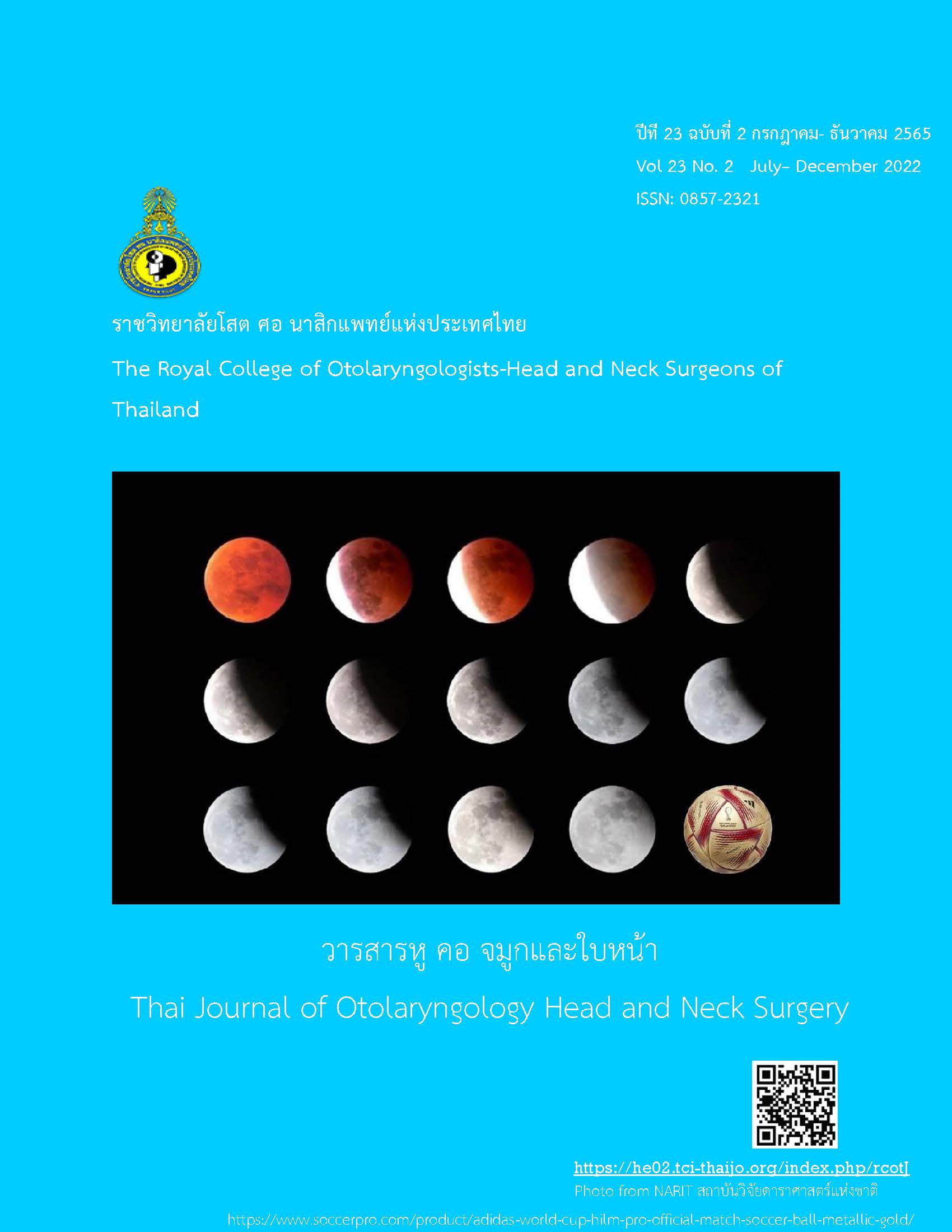Ortner’s syndrome with left vocal cord paralysis secondary to thoracic aortic aneurysm: A case report
Main Article Content
Abstract
Ortner’s syndrome or cardiovocal syndrome is a rare condition caused by compression of the left recurrent laryngeal nerve (RLN) by thoracic aortic aneurysm. We report a case of a 78-year-old Thai female who had been complaining of hoarseness of voice for 2-3 weeks. Physical exam demonstrated evidence of left vocal cord paralysis without any suspicious mucosal lesions or palpable neck mass. Initial work up with chest radiograph showed a lobulated soft tissue mass at left superior mediastinum which was subsequently found to be a 6.7-cm saccular aneurysm with mural thrombus and extending into aortopulmonary window on chest CT scan. The aneurysm compressed the expected course of the left RLN, resulting in left vocal cord paralysis. She underwent thoracic endovascular aortic repair (TEVAR). In advanced age patients with hoarseness, aside from malignancy, rare but potentially life threatening causes such as Ortner’s syndrome should also be considered in the differential diagnosis.
Abbreviations: RLN = Recurrent laryngeal nerve, TEVAR = Thoracic endovascular aortic repair, AP window = aortopulmonary window
Keywords: Ortner’s syndrome, thoracic aortic aneurysm, recurrent laryngeal nerve, vocal cord paralysis.
Article Details

This work is licensed under a Creative Commons Attribution-NonCommercial-NoDerivatives 4.0 International License.
ต้นฉบับที่ส่งมาพิจารณายังวารสารหู คอ จมูก และใบหน้า จะต้องไม่อยู่ในการพิจารณาของวารสารอื่น ในขณะเดียวกันต้นฉบับที่จะส่งมาจะผ่านการอ่านโดยผู้ทรงคุณวุฒิ หากมีการวิจารณ์หรือแก้ไขจะส่งกลับไปให้ผู้เขียนตรวจสอบแก้ไขอีกครั้ง ต้นฉบับที่ผ่านการพิจารณาให้ลงตีพิมพ์ถือเป็นสมบัติของวารสารหู คอ จมูกและใบหน้า ไม่อาจนำไปลงตีพิมพ์ที่อื่นโดยไม่ได้รับอนุญาต
ตารางแผนภูมิ รูปภาพ หรือข้อความเกิน 100 คำที่คัดลอกมาจากบทความของผู้อื่น จะต้องมีใบยินยอมจากผู้เขียนหรือผู้ทรงลิขสิทธิ์นั้นๆ และใหร้ะบุกำกับไว้ในเนื้อเรื่องด้วย
References
Chen RF, Lin CT, Lu CH. Ortner’s syndrome-A rare cause of unilateral vocal cord paralysis: A case report. Kaohsiung J Med Sci
;25:203-206.
Shahul HA, Manu MK, Mohapatra AK, Magazine R. Ortner’s syndrome. BMJ case Rep 2014;doi:10.1136/bcr-2013- 200950.
Glazer HS, Aronberg DJ, Lee JK, Sagel SS. Extralaryngeal causes of vocal
cord paralysis: CT evaluation. AJR 1983;141:527-531.
Hurtarte Sandal AR, Carlos Zamora R, Gomez Carrasco JM, Jurado Ramos A. Ortner’s syndrome: a case report and review of the literature. BMJ Case Rep 2014;doi:10.1136/bcr-2013-202900.
Paquette CM, Manos DC, Psooy BJ. Unilateral vocal cord paralysis: A review of CT findings, mediastinal causes, and the course of the recurrent laryngeal nerve. Radiographics 2012;32:721-740.
Subramaniam V, Adarsha Herle TV, Mohammed N, Thahir M. Ortner’s syndrome: case series and
literature review. Braz J Otolaryngol 2011;77: 559-562.
Ali Shah MU, Siddiqi R, Chaudhri MS, Khan AA, Chaudhry I. Aortic aneurysm: A rare cause of
Ortner’s syndrome. Journal of the college of Physicians and Surgeons Pakistan 2014;24:282-284.
Mulpuru SK, Vasavada BC, Punukollu GK, Patel AG. Cardiovocal syndrome: A systematic review.
Heart, Lung and Circulation 2008;17:1-4.
Zaharudin I, Azizi ZA. Thoracic aortic aneurysm as a cause of Ortner’s syndrome-A case series.
Med I Malaysia 2016;71:139-141.
Song SW, Jun BC, Cho KJ, Lee S, Kim YJ, Park SH. CT evaluation of vocal cord paralysis due to thoracic disease: A 10-year retrospective
study. Yonsei Med J 2011;52:831-837.
Wang TK, Desai MY. Thoracic aortic aneurysm: Optinal surveillance and treatment. Cleveland
clinic journal of medicine 2020;87:557-568.
Sharples L, Sastry P, Freeman C, Bicknell C, Chiu Y, Vallabhaneni SR, et al. Aneurysm growth,
survival, and quality of life in untreated thoracic aortic aneurysms: the effective treatments for
thoracic aortic aneurysms study. European Heart Journal 2022;43:2356–2369.
Hiratzka LF, Bakris GL, Beckman JA, Bersin RM, Carr VF, CaseyJr DE, et al.
ACCF/AHA/AATS/ACR/ASA/SCA/SCAI /SIR/STS/SVM Guidelines for the diagnosis and management of patients
with thoracic aortic disease: a report of the American College of Cardiology Foundation/American
Heart Association Task Force on Practice Guidelines, American Association for Thoracic Surgery,
American College of Radiology, American Stroke Association, Society of Cardiovascular
Anesthesiologists, Society for Cardiovascular Angiography and Interventions, Society of
Interventional Radiology, Society of Thoracic Surgeons, and Society for Vascular Medicine.
Circulation 2010;121:e266-e369.
Stachler RJ, Francis DO, Schwartz SR, Damask CC, Digoy GP, Krouse HJ, et al. Clinical Practice
Guideline: Hoarseness (Dysphonia) (Update). Otolaryngology–Head and Neck Surgery 2018;158:1 -42.


